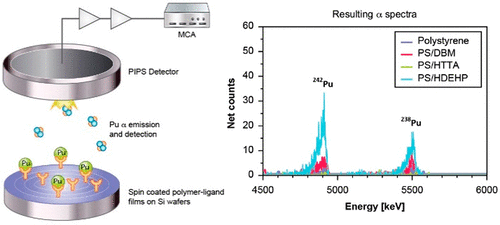当前位置:
X-MOL 学术
›
Anal. Chem.
›
论文详情
Our official English website, www.x-mol.net, welcomes your feedback! (Note: you will need to create a separate account there.)
Functionalized Polymer Thin Films for Plutonium Capture and Isotopic Screening from Aqueous Sources.
Analytical Chemistry ( IF 7.4 ) Pub Date : 2020-03-24 , DOI: 10.1021/acs.analchem.9b05758 James C Foster 1 , Samantha A Starstrom 1 , Timothy A DeVol 2 , Brian A Powell 2 , Scott M Husson 1
Analytical Chemistry ( IF 7.4 ) Pub Date : 2020-03-24 , DOI: 10.1021/acs.analchem.9b05758 James C Foster 1 , Samantha A Starstrom 1 , Timothy A DeVol 2 , Brian A Powell 2 , Scott M Husson 1
Affiliation

|
The rapid screening of plutonium from aqueous sources remains a critical challenge for nuclear nonproliferation efforts. The determination of trace-level Pu isotopes in water requires offsite sample preparation and analysis; therefore, new methods that combine plutonium purification, concentration, and isotopic screening in a fieldable detection system will provide an invaluable tool for nuclear safeguards. This contribution describes the development and characterization of thin polymer–ligand films for the isolation and concentration of waterborne Pu for direct spectroscopic analyses. Submicron thin films were prepared through spin coating onto Si wafers and consisted of combinations of polystyrene (PS) with dibenzoylmethane, thenoyltrifluoroacetone, and di(2-ethylhexyl)phosphoric acid (HDEHP). Pu uptake studies from solutions at pH from 2.3 to 6.3 indicated that only films containing HDEHP exhibited significant recovery of Pu. High alpha spectroscopy peak energy resolutions were achieved for PS-HDEHP films over a range of film thicknesses from 30 to 250 nm. A separate study was performed to evaluate uptake from a primarily Pu(V) solution where it was observed that doubling the HDEHP loading in the film increased uptake of Pu by an order of magnitude. X-ray photoelectron spectroscopy (XPS) analysis revealed that HDEHP was highly concentrated within the first few nanometers of the film at the higher loading. XPS analysis also revealed that, in the presence of water, HDEHP was stripped from the surface layer of the film at circumneutral pH. While significant losses of ligand were seen in all samples, higher loadings of HDEHP resulted in measurable amounts of ligand retained after a 12-h soak in water. Findings of this study are being used to guide the development of thin-film composite membrane-based detection methods for the rapid, fieldable analysis of Pu in water.
中文翻译:

用于从水中捕获Capture和进行同位素筛选的功能化聚合物薄膜。
从水源快速筛查remains仍然是核不扩散努力的关键挑战。水中痕量Pu同位素的测定需要异地样品制备和分析;因此,将a纯化,浓缩和同位素筛选结合在一起的新方法在一个可现场使用的检测系统中将为核保障提供宝贵的工具。这一贡献描述了聚合物-配体薄膜的开发和表征,用于分离和浓缩水性Pu,用于直接光谱分析。通过旋涂到硅片上制备亚微米薄膜,该薄膜由聚苯乙烯(PS)与二苯甲酰甲烷,壬基三氟丙酮和二(2-乙基己基)磷酸(HDEHP)的组合组成。pH从2.3到6的溶液中Pu的吸收研究。图3表明仅含有HDEHP的膜显示出明显的Pu恢复。PS-HDEHP薄膜在30到250 nm的薄膜厚度范围内获得了高α光谱峰值能量分辨率。进行了另一项研究以评估主要是Pu(V)溶液的吸收,其中观察到,薄膜中HDEHP含量加倍会使Pu的吸收增加一个数量级。X射线光电子能谱(XPS)分析表明,HDEHP在较高的载荷下高度集中在薄膜的前几个纳米内。XPS分析还显示,在水存在下,在环境pH值下,HDEHP从薄膜的表面层剥离。尽管在所有样品中均观察到配体的大量损失,较高的HDEHP负载量导致在水中浸泡12小时后可测量的配体保留量。这项研究的结果被用于指导基于薄膜复合膜的检测方法的发展,用于快速,现场分析水中的Pu。
更新日期:2020-03-26
中文翻译:

用于从水中捕获Capture和进行同位素筛选的功能化聚合物薄膜。
从水源快速筛查remains仍然是核不扩散努力的关键挑战。水中痕量Pu同位素的测定需要异地样品制备和分析;因此,将a纯化,浓缩和同位素筛选结合在一起的新方法在一个可现场使用的检测系统中将为核保障提供宝贵的工具。这一贡献描述了聚合物-配体薄膜的开发和表征,用于分离和浓缩水性Pu,用于直接光谱分析。通过旋涂到硅片上制备亚微米薄膜,该薄膜由聚苯乙烯(PS)与二苯甲酰甲烷,壬基三氟丙酮和二(2-乙基己基)磷酸(HDEHP)的组合组成。pH从2.3到6的溶液中Pu的吸收研究。图3表明仅含有HDEHP的膜显示出明显的Pu恢复。PS-HDEHP薄膜在30到250 nm的薄膜厚度范围内获得了高α光谱峰值能量分辨率。进行了另一项研究以评估主要是Pu(V)溶液的吸收,其中观察到,薄膜中HDEHP含量加倍会使Pu的吸收增加一个数量级。X射线光电子能谱(XPS)分析表明,HDEHP在较高的载荷下高度集中在薄膜的前几个纳米内。XPS分析还显示,在水存在下,在环境pH值下,HDEHP从薄膜的表面层剥离。尽管在所有样品中均观察到配体的大量损失,较高的HDEHP负载量导致在水中浸泡12小时后可测量的配体保留量。这项研究的结果被用于指导基于薄膜复合膜的检测方法的发展,用于快速,现场分析水中的Pu。


























 京公网安备 11010802027423号
京公网安备 11010802027423号